Manufacturer: Formac
Price: about $140

ProTv Product Box

About ProTv (Don't be fooled by the FireWire icon as that feature has basically nothing to do with this specific product.)
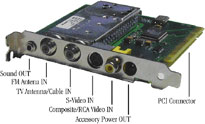
Notice the arranged ports. The power out port was not addressed.
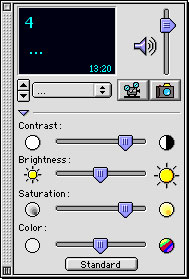
The Remote Control Window
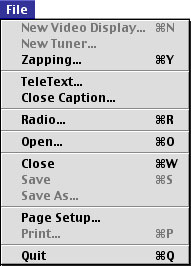
File Menu - TeleText is for European customers only.
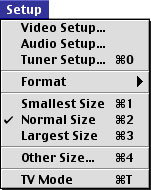
You can adjust your settings and change the video input window size.
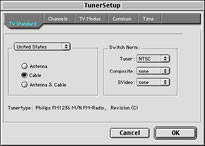
TunerSetup allows you to take some control.
The GUI in the ProTV software is not always set to today's accepted standards.
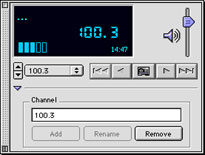
Radio Controls. The 3/5 bar indicates the signal strength.
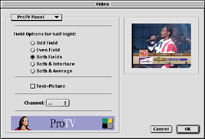
Choose some specific options on how to handle your TV input.
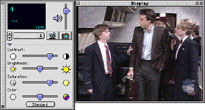
With the remote at hand, you can watch TV in a 320x240 window, allowing it to be put in the background. (You can even use regular screenshots to capture video input, which not all cards allow you to do. The image is from SNL, an interesting airplane sketch.)

A screen capture at a full 640x480. With digital cable, you don't need to physically look at a TV Guide; it's built into your TV viewing experience. The drawback is that even though you pay extra for this service, you get to look at irritating ads.
As so many products have been designed for the Mac, we can actually integrate many of our electronics into a single Mac. Here, the items that we are integrating are the TV and the radio. We can watch TV on our Macs and even listen to the FM bands of the radio, while we work. When we watch certain things that we like, ProTV will allow us to record videos as well as still shots, acting as a VCR. Before you toss your TV, VCR, and stereo, let's have an in-depth look at how this will work.
Details:
ProTV is a PCI card that fits into any PCI equipped Mac, including G4's. It has input ports for your antenna/cable, S-video, as well as composite video. Since the audio is captured at the PCI level, it needs to be routed to your system. One option is to use an internal audio cable so that you can connect the PCI card to your CD-ROM's audio port, or directly on the motherboard. Some computer's don't allow this, such as the G4's which use digital sound for CD's. This is why the ProTV's external sound output port is useful; you can connect it to your system's sound input port. There is also another port for your radio antenna. The software allows you to harness this hardware by having control over it. You can view 125 channels, change aspect ratios, save video, capture stills, tune into radio frequencies, and perform a few other minor tasks.
Details: Getting Started
A brief informative message would be appropriate here. We are not new to the experiences of video cards and the Mac. We have used and review items such as Micro Conversions' Video Wizard, which was and still is a great product. It is sort of a basis for the ProTV Stereo
We installed and tested the ProTV card on a G4. The PCI card stubbornly fit into the computer's slot, but after some time it was finally closed up. The cable TV input is simply plugged and screwed into the appropriate port, while the sound out is connected to the G4's microphone in port. (I suppose this means I won't be using my microphone any time soon.) The radio antenna port is peculiar at best. It is the exact same as the TV port, a 75 ohm interface. You can plug a, well, umm, actually I'm a bit confused with the radio port. Until a few days ago, I have never seen a radio antenna plug into a TV port. Apparently they make some special antennas that use coaxial cable to interface to the radio port. Such an item is not included with the ProTV product. Users will have to find their own antenna if they intend to use the radio feature. After restart with the hardware and cables intact, the software can be installed. It can be straightforward, but there are many options for you to toy with. You can change the color, contrast, and many of the things you would expect on a regular TV. Preferences and such need to be set though. Within some time, you can have everything working nicely. The cable TV picture we observed was quite sharp. (Note: If you plug the TV feed into the radio port which looks the same, your picture quality will be dramatically worse.) Yes, it is possible to view a better video quality on your monitor than on your TV. Many TV's use anti-aliasing to create smooth transitions. Clearly, the dots on your monitor are not as large as the dots on your TV. Also, most people don't have 32 inch monitors, so the picture is not expanded as much. A remote control like window will allow you to change channels and volume, while you pick a suitable video size. If you want to work in the background, 320x240 pixels is a good choice. If you want to seriously watch something, go for the full 640x480 pixels. Remember, if your monitor resolution is greater than this, say 1280x1024, your full screen mode will only appear to be a 640x480 box in the center of your screen. To view TV in full screen mode, you need to comply with NTSC standards. You need to set your resolution to 640x480, then view TV in full mode. All windows will disappear and you are left with nothing but TV video. If you commonly work in something other than this resolution, you may find that switching back and forth is cumbersome. There is an option that allows the ProTV software to automatically switch your screen resolution to the best available, but I found this to be less great than I had thought. It does switch to 640x480 resolution, but it kills the hertz. I think it takes it down to a slow 60Hz, which actually hurts your eyes when viewing it on a computer screen. If you manually switch to a 640x480 resolution, you will have a much higher hertz and your picture quality will seem more smooth. I can't really offer much more advice, but those of you who know NTSC standards are accustomed to these video qualities. (Be glad you don't need to use 640x480 @ 60Hz, which is NTSC. Your eyes can tell the difference with such a low refresh rate. This is also the same reason why you see lines in computer monitors when they are shown on TV. You have a 60Hz TV showing a greater Hz screen, say 85 Hz. The frequencies don't match.) ProTV delivers the video input at 30 fps, and doesn't require processing from your system to handle it (usually). If you put the video in the background and work in other applications, you may notice the video to freeze or drop to very low frame rates. I didn't image this to happen, as the PCI hardware should be performing the work. Let's go back to the audio for a moment; the sound input can be monitored and utilized from various sources. Some of them are the mic input port, the CD-ROM, or the card's own sound. However, the only real choice is the mic input. You can choose the quality, mode, and sound level. I set it at 44.1KHz, 16 bit, stereo, 100%. You may think that all of the settings are slightly overwhelming if you just want to get the card to do its basic job, and you would be partially correct. By following the simple directions provided, you won't accomplish much. Many elements need to be tweaked to get the potential out of the product.
Details: Observed Problems & Partial Solutions
Unfortunately, not everything worked out to the claims or misleading claims branded on the box. Clearly, the audio needs to be routed to your system with some sort of cable. The product includes none of any kind, which contradicts what is written in the support files. Let's hope you have something to do the job; I found one laying around in the stocked parts area. After you connect this and watch something on video, say a person speaking, you may see video in a way in which you have rarely ever before. People speak, and a partial second later, you hear sound. After their lips stop moving, sound still pours out of your speakers. Yes, the video and audio are not synced. For me, this created some added confusion when I just wanted to simply rest and watch a few minutes of TV. We also noticed that since the sound was routed in and out of various parts of the computer, the sound level was much quieter. You may have your main sound level set to 50%, but when you listen to something in the ProTV application, it will sound more closer to 20%. You could turn up the audio gain in the prefs, but let's consider the quality. So, you will need to crank up your main sound level volume whenever you launch the software. Don't forget to turn it back down when you finish viewing the media. Also when you are in the middle of listening to something, the sound will simply drop out. You will need to play around with the settings and suddenly the sound will come back. There is a very good chance that this will happen when you switch between running applications. Occasionally, you may notice that the software freezes for no apparent reason. It will crash your system and you will need to force a restart or kill the main power on your machine. Indeed, the product has a few quirks that need to be addressed. We even downloaded a new version of the software, which is supposed to take care of various problems. Unfortunately, some of them still exist even with the new software.
We contacted Formac Support to better voice these problems. Although we can usually troubleshoot most of the products we test, we actually had some confusing questions that we really needed support with. When we contact a company's technical support, we usually present ourselves as a regular consumer. (If we stated that we were reviewing the product and had a few questions, I would bet that the tech support rep would give special treatment to our questions. This doesn't help when we want to tell readers about the quality of the tech support.) Formac tech support claims that most questions are responded to within 24 business hours. We submitted the questions, and noted the elapsed time. After four business days, it was time to send another message and see if anyone was alive on the receiving end. With some beefed-up tone, we managed to receive a response in much less time. We presented the issues above, and observed the suggestions. The audio cable issue, or lack of a provided cable, was completely blown off. I suppose it would have been treated the same if the message contained a few blank lines. Did the support group think those questions were invisible? In response to the video and audio sync, Formac advised to turn Virtual Memory off. This can be a huge problem if you use programs that work better and require less memory when VM is turned on. Surprisingly though, if you turn VM off, the video and audio sync is much nicer. It's a difficult choice for the user though. Since the sound seems quieter, dump the system sound prefs, or so that is what they suggested. Honestly, I'm not about to loose my sound settings just so I can prove their theory wrong. It is a hardware problem, not a preference error. Since the application freezes, they suggested trashing the app's prefs file. This would make sense here, as it will restore proven working conditions to the software. We also asked about the unheard-of 75 ohm antennas, which was replied to with a mere web address. They suggested Terk, a company that actually makes these things. An antenna will cost upwards of ten dollars. Apparently users need to purchase additional hardware and again tweak their settings to perform the actions stated on the product box.
Details: Software
Utilizing this hardware is made possible by the ProTV software. Just open the app, and your video input is promptly displayed on the screen. You can choose the source, of course: TV, composite, or S-Video. For the TV, you can easily flip through the channels and even assign names to specific channels, such as CNN. The standard options found on a regular TV are also available here, that is, the ability to change the color settings. The audio settings can be set as well, allowing for 16 bit, 44.1KHz, stereo quality sound. Capturing still screenshots is easy by simply clicking a button, selecting it from the menu, or using a keyboard shortcut. You have the option of creating PICTs or JPEGs. The other nice feature is the ability to save captured movie files. What you see in your video window is recorded. The problem with this is that the storage space for good quality movies is huge. You can record at about 6 MB/s, although you have options to increase or decrease the quality/compression. So, if you wanted to record a 30 minute show, you would need about 10.8 GB of disk space. When you are recording this, your viewing frame rate will drop to about 4 fps. It is apparent that the PCI hardware cannot handle demanding tasks. The software has basically two modes, either a video window or a radio window. You can switch to the radio and familiar options are available. You can change the frequencies and record audio. Assigning names and favorites to certain frequencies is also supported. When the features hold up to their duties, the software works well.
Back to the comparison to the Video Wizard. The Wizard's software worked well; it was extremely rare for it to crash. It didn't have as many features as the ProTV does, but I would have traded the ProTV's buggy features for the reliable features of the Wizard, even if there were less of them. The Wizard also included a video out port, which I would have traded for the ProTV's radio input port. Formac's product did not live up to the full potentials of the Video Wizard, which is now at least three years old.
Conclusion
If you are looking for a good PCI card that will allow you to watch TV and import analog video, this may be for you. The main problem with this product is that it is not really plug and play. Sure, you can plug it in and try to play. But, you will most likely need to make many adjustments and reconfigurations to get ProTV to perform the statements on the product box. You will need to buy a special radio antenna, rework the audio wires, try to fix the frequent crashing, and live with some other problems that cannot be fixed by the user. A price reduction may help consumers with this product, since there are many problems with ProTV. It would be a tradeoff though, a sad tradeoff. Formac should have fixed everything before bringing this product to market, in which case many things would have operated more smoothly. The product is good though, after all, it can manage video input. But if you plan to purchase ProTV Stereo, be prepared to spend some time tweaking the settings for the hardware and software.
Rating
6/10 ![]() 6/10
6/10
